The Boys in the Band and the Limitations of Gay History on Stage
The key to understanding the significance of The Boys in the Band, which is marking its fiftieth anniversary with a production on Broadway featuring a starry, all-gay cast, is a nasty line that Jim Parsons speaks to Zachary Quinto.
Parsons portrays Michael, an unemployed writer, who is throwing a birthday party for Quinto’s Harold, the self-described “thirty-two-year-old, ugly, pockmarked Jew fairy.” At one point, Michael tells the gathering that Harold has been saving up pills he can use to kill himself. “I tell you right now, Hallie. When the time comes, you’ll never have the guts. It’s not always like it happens in plays, not all faggots bump themselves off at the end of the story.”
It’s not always like it happens in plays.
This implies, of course, that, in 1968, when Mart Crowley wrote The Boys in the Band, it always happened that way in plays. The gay characters that existed on stage (and on screen) were largely pathetic figures, or villains, whose death by suicide was preordained. Or, with their sexual orientation only implied, they were peripheral figures that functioned as living punch lines.
To the audiences of 1968, The Boys in the Band offered a contrast, a play full of reasonably feasible gay men. But in 2018, given a perspective formed by a half-century of increasingly diverse and sophisticated plays with LGBT themes and characters, along with a greater public awareness and societal acceptance of LGBT people, it’s difficult to see The Boys in the Band as a quantum leap from what preceded it. The script feels dated—the characters stereotypes of unhappy homosexuals who may well end up killing themselves, even though they don’t do so by the curtain call.
In 1968...the gay characters that existed on stage (and on screen) were largely pathetic figures, or villains, whose death by suicide was preordained. Or, with their sexual orientation only implied, they were peripheral figures that functioned as living punch lines.
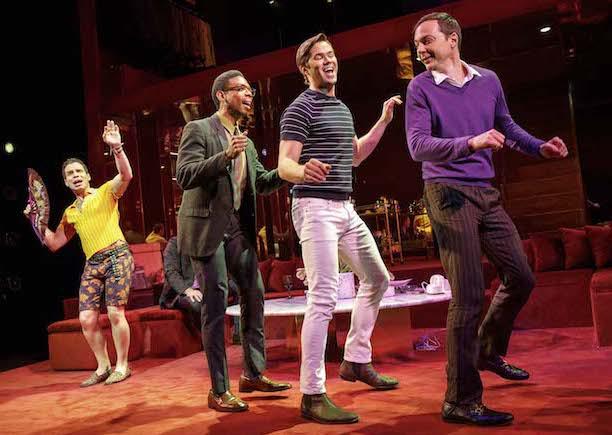
Yet the first Broadway production of The Boys in the Band is, as I wrote in my opening night review, fun and funny. It is entertaining, full of clever quips. It creates an inviting sense of camaraderie. But it’s also something more than that. It’s a celebration of where we are. All nine actors are openly gay men, as are the director Joe Mantello and all five producers including Ryan Murphy (creator of such TV series as Glee, American Horror Story, and Feud). Several are famous—TV stars (Parsons of The Big Bang Theory, Matt Bomer of White Collar), movie stars (Quinto of the Star Trek films), Broadway stars (Andrew Rannells of Book of Mormon, Hamilton.) Even Cowboy, the young, dumb hustler given to Harold as a birthday gift, is portrayed by Charlie Carver, a celebrity by dint of his teenage stardom in Teen Wolf. These good-looking, successful, popular out gay actors aren’t so much re-creating gay history, or even honoring gay history, when they portray these brittle homosexual characters from the past. By their very participation in this production, they are making history.
It’s worth noting that many performers still consider it a risk to come out; actor Lee Pace, who portrays a Mormon lawyer who comes out of the closet in the current Broadway revival of Angels in America, just recently came out himself as “queer.”
The Boys in the Band is not a great play, the way Angels in America is a great play. Both have become period pieces, but the first is stuck in its period, while the latter is now a period piece that transcends its era.
What if these two plays were actually history plays? How would either play be different if it had been written today, with insights presumably gained by the passage of time? We can’t know, but we can see how new gay plays look back at past eras. As it happens, two plays that ran in New York in May offer very different examples of focusing inventively on actual gay figures from history.
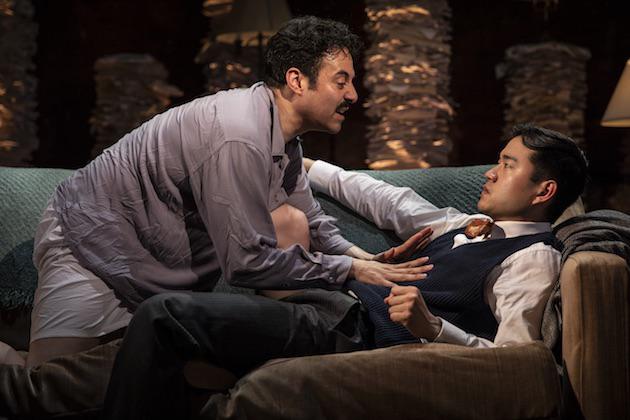
A good way to introduce The Gentleman Caller is to pose the question I asked in my monthly quiz:
In the two-character play, what do the playwrights Tennessee Williams and William Inge spend time doing?
1. Discussing the relative merits of Elizabeth Taylor and Marilyn Monroe for the Hollywood versions of their plays.
2. Comparing their experiences as the patient of the same psychoanalyst, Dr. Lawrence Kubie.
3. Agreeing that the triangular relationship presented in Inge’s Come Back, Little Sheba bears some resemblance to the dynamics in Williams’ A Streetcar Named Desire.
4. Smooching.
The answer is 4. Smooching. The play by Philip Dawkins imagines only the characters’ first two encounters, in the early 1940s, before either of them became major American playwrights of the 20th century. It is a historical fact that Tennessee Williams was overseeing the out-of-town try-out of the play that would become The Glass Menagerie when he met William Inge, who was at the time a drama critic and arts reporter for a newspaper in St. Louis, the city where Williams’ family still lived. Inge intended to interview Williams, but as Williams noted in his memoirs, the two socialized as well, attending a concert of the St. Louis Symphony together. Although only two years older, Williams would become Inge’s mentor, encouraging him to pursue his interest in playwriting, sending an Inge manuscript to his own literary agent Audrey Wood, who became Inge’s as well. Over the years, they developed a complicated relationship, from friends to peers to rivals, with Inge outshining Williams in the 1950s, with a string of hits on Broadway and in Hollywood—Come Back, Little Sheba, Picnic, Bus Stop, The Dark at the Top of the Stairs—during a fallow period in Williams’ own career.
Both men were gay, but neither ever publicly admitted to a sexual relationship, and historians and biographers have only speculated that they might at one time have been lovers. Yet in The Gentleman Caller, there is sexual tension from the get-go, and the play proceeds as a sexual cat and mouse game that involves a lot of physical contact.
Dawkins has clearly done research into both men, and tries to capture their voices (more successfully with Williams). But his interest seems to lie less in the careers of these two playwrights or even in the sexual history of these two gay men, but in the history of any gay men in the 1940s and what impact their sexuality had on their lives. In the play, Bill Inge is in the closet and Tenn Williams is more open (a relative term given the era) and much of their interaction reflects this different way of responding to the world.
An interesting aspect of the New York production was the casting—Daniel K. Isaac, a Korean-American actor, portrayed William Inge and Juan Francisco Villa, Colombian-America actor, was Tennessee Williams—which I took in part as a subtle commentary on the invisibility of gay people of color in the era in which the play takes place (and the relatively low visibility on New York stages now).
Dawkins makes a fascinating effort to establish a correspondence between homosexuality and artistic endeavor. In trying to encourage Bill to take up playwriting, Tenn makes a claim for the advantage of Otherness.
This writing, this searching, this is how fugitives reproduce! It’s our nature. Do you honestly think a heterosexual could have written Remembrance of Things Past? Or The Sun Also Rises?! Or the BIBLE?! Come off it, Bill! Only a fugitive, only a man on the run could write something so vital! Why do you think we sexual inverts make such dedicated artists and drunks? Because it gives us something to do instead of be!
Proust was undeniably gay; some recent biographies have explored Ernest Hemingway’s sexuality. But the line about the Bible’s authors is cheekily subversive—or what one might call campy, although the more preferred word these days seems to be “baroque.”
Yet, as in the older plays to which Boys in the Band refers (and as in Boys in the Band itself), the characters talk about suicide:
“The truth is I would very much like to give up writing,” Tenn says, “but it would be tantamount to suicide for me.”
“They say that every twenty minutes somebody in America kills himself,” Bill replies, oddly.
“That’s absurd! I kill myself much more often than that,” Tenn jokes.
It’s true that this is a jokey reference. It’s also true that the real William Inge did in fact kill himself at the age of sixty. But there is something disturbing about the lack of any context. The audience is probably meant to understand in both plays that the homosexuals are unhappy because they’re stigmatized by the world at large, but there’s nothing to stop an unenlightened theatregoer from wondering whether there’s something intrinsically off-balance in the condition of homosexuality.
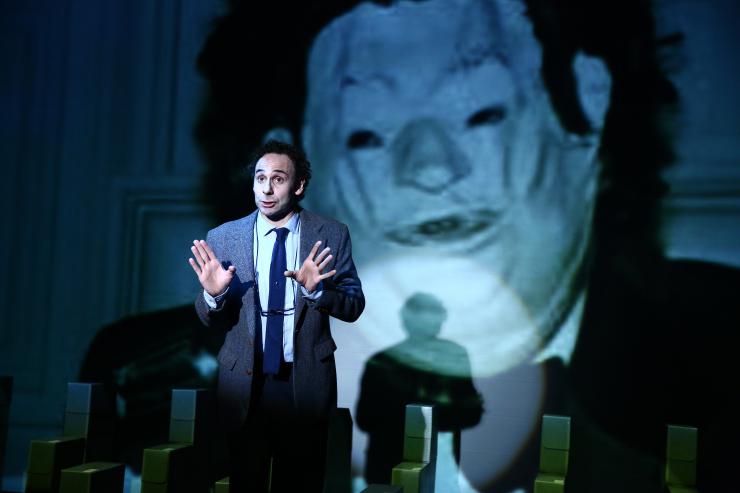
As a tonic, consider 217 Boxes Of Dr. Henry Anonymous by Ain Gordon, which ran briefly at the Baryshnikov Arts Center in May. It is a work of documentary theatre, that focuses on the true story of Dr. John Fryer, a psychiatrist who in 1972 demanded that homosexuality be declassified as a mental illness in a confrontation before the annual conference of the American Psychiatric Association, where he wore a rubber mask to protect his identity and declared (through a mic that distorted his voice): “I am a homosexual. I am a psychiatrist.”
Gordon reportedly rummaged through the 217-box archive of Fryer’s papers, housed at the Historical Society of Pennsylvania after the psychiatrist’s death in 2003. He came up with three characters—none of them Dr. Fryer himself—who one after the other deliver half hour monologues amid a set full of those archive boxes, to piece together not just Dr. Fryer’s life and work but the times he lived in.
The first character tells us he was born in 1895, that in the 1960s he recruited Dr. Fryer to help him assist homosexual men who were in trouble with the law—help by claiming to be able to treat them, and thus allow the court to dismiss the charges and be rid of the whole distasteful business. “I was the Cro-Magnon of homosexual freedom—so John could walk upright—so you could march!” He categorizes himself as “high swish” which he explains was someone “preposterous enough to be tolerated by the intolerant.” The choice for most of the twentieth century was “be anonymous or play the fool or both.” In one way, he says, he misses the old days: “Yank from me my disguise, legalize my heart, you leave me only with my dull name, Alfred A. Gross.” But in the stories of the clients, we see a direct effect of the state’s oppression on their lives and emotional states.
The second character is Mrs. Luder (who was never a Mrs.; she used it as “a one-word disguise”). She became Dr. Fryer’s secretary when she was fired from her long-time job because she had turned sixty-seven. This was after Fryer’s notorious anonymous confrontation with his fellow psychiatrists. She worked with him for the next twenty-four years, until the 1990s, living to ninety-one, and their relationship had all the ups and downs, and emotional closeness albeit in disguise, of a marriage. There are humorous moments of culture clash that succinctly if abstractly sum up what it’s like to be working for a liberation movement. “I learned to accept, then learned I should not need to accept, then learned I should not see the difference, then learned I should not erase the difference,” Mrs. Luder says. “Exhausting—these men!” It is through Mrs. Luder’s eyes that we see the devastation of AIDS, the patients who show up with clothes that are now too loose.
The final character is Dr. Fryer’s father: “I was proud of my son. I just didn’t know how to understand about...” Like the others, he is a ghost, but even more so: he died before Fryer made his speech, but he’s the one who delivers it for us. It’s a stirring call to arms “to change the attitudes of homosexuals and heterosexuals toward homosexuality. For all of us have something to lose” —delivered at a time, as 217 Boxes makes clear, when the general public, and the mechanisms of authority, still viewed homosexuality as a sin, a crime and an illness. This was—it’s bracing to note—four years after The Boys in the Band was first presented on stage. There’s the context that’s missing from the party on Broadway.
Jonathan Mandell’s NewCrit piece usually appears the first Thursday of each month. See his previous pieces here.

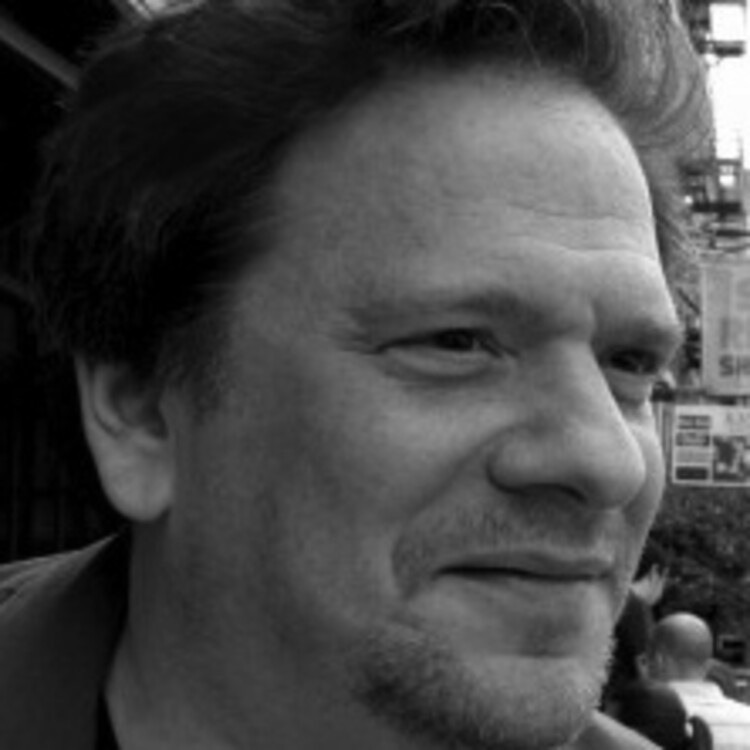
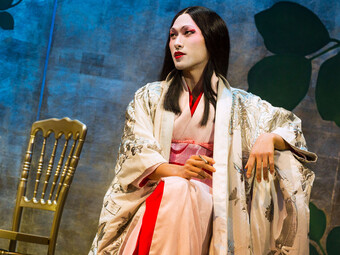


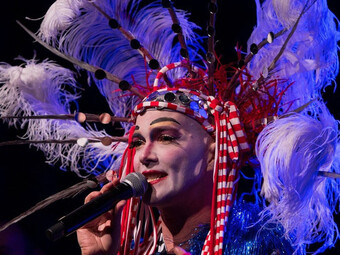


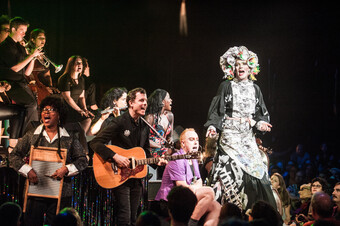

Comments
The article is just the start of the conversation—we want to know what you think about this subject, too! HowlRound is a space for knowledge-sharing, and we welcome spirited, thoughtful, and on-topic dialogue. Find our full comments policy here